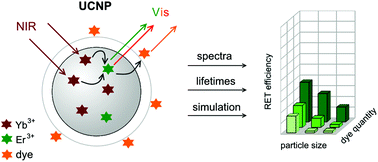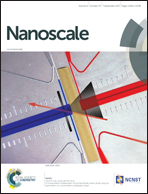Quantitative assessment of energy transfer in upconverting nanoparticles grafted with organic dyes†
Abstract
Upconverting nanoparticles (UCNPs) are luminophores that have been investigated for a multitude of biological applications, notably low-background imaging, high-sensitivity assays, and cancer theranostics. In these applications, they are frequently used as a donor in resonance energy transfer (RET) pairs. However, because of the peculiarity and non-linearity of their luminescence mechanism, their behavior as a RET pair component has been difficult to predict quantitatively, preventing their optimization for subsequent applications. In this article, we assembled UCNP–organic dye RET systems and investigated their luminescence decays and spectra, with varying UCNP sizes and quantities of dyes grafted onto their surface. We observed an increase in RET efficiency with lower particle sizes and higher dye decoration. We also observed several unexpected effects, notably a quenching of UCNP luminescence bands that are not resonant with the absorption of organic dyes. We proposed a semi-empirical Monte Carlo model for predicting the behavior of UCNP-organic dye systems, and validated it by comparison with our experimental data. These findings will be useful for the development of more accurate UCNP-based assays, sensors, and imaging agents, as well as for optimization of UCNP–organic dye RET systems employed in cancer treatment and theranostics.



 Please wait while we load your content...
Please wait while we load your content...